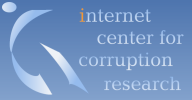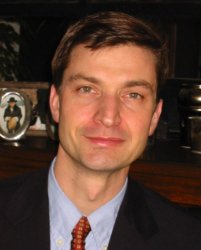
| Home → Corruption Perceptions Index → Childhood Days |  |
| Home | |||
| Contact information | |||
| Research Area | |||
| Corruption Perceptions Index | |||
| 2009 and later | 2008 | 2007 | |
| 2006 | |||
| 2005 | |||
| 2004 | |||
| 2003 | |||
| 2002 | |||
| 2001 | |||
| 2000 | |||
| older indices | |||
| childhood days | |||
| Lecture and Workshops |
Measuring the dark side of human nature: The birth of the Corruption Perceptions Index
In 1995, the Corruption Perceptions Index thrust Transparency International - a fledgling NGO - into the media spotlight. Today, TI is considered a global leader in publishing assessments of corruption incidence and trends and the release of the annual index is eagerly awaited by governments, private companies, academics, NGOs and the media worldwide. Johann Graf Lambsdorff of the University of Passau and TI's adviser on the index recalls the beginnings of the CPI.
In 1995, as a new member of Transparency International, I attended TI's annual general meeting in Milan, Italy. As an economist, I was tired of the various mainstream strands of economic research and was looking for more challenging approaches - those closer to measuring the dark side of human nature. TI had invited a well-known political economist from Yale University, Susan Rose-Ackerman, to the meeting in order to explore joint research initiatives. Speaking with Susan and members of TI national chapters was inspiring. There must be some way, I thought, of combining empirical research on corruption with the capacity of Transparency International.
I recall the exact day that the idea of the CPI was born because it happened to be my 30th birthday: 27 March 1995. I was in my hotel room (a lonely place to celebrate one's birthday) thinking about how to deepen research on corruption. It struck me that an index that compared levels of corruption across countries could be a feasible joint project. Not only would it help Transparency International raise awareness about the levels of corruption globally, but it would also provide the academic community with the raw data desperately needed to analyse the causes and consequences of corruption in a cross-section of countries. By involving academia (the work is now co-ordinated under my leadership at the University of Passau but I was then at the University of Göttingen) the academic quality and impartiality would be well signalled to outsiders. Transparency International, with its name and reputation, would stand for the legitimacy of the index and help in finding partners.
The next morning, I presented to the assembly the idea of compiling such an index based on the assessment of well-informed experts. The idea was welcomed, although many important questions had not been clarified in my brief statement. Initially, I thought that TI members and associates could serve as a survey sample. At a later stage I decided that the index would be stronger and easier to defend as a composite index - building on survey work carried out by third parties. Finding such partners, understanding their approaches, advising them with regard to appropriate questions on corruption, and seeking statistically robust methods for aggregating the data became the main areas we later concentrated on.
In June 1995, I was contacted by Rüdiger Jungblut, a journalist from the German investigative weekly magazine Der Spiegel. I mentioned the project to him and sent him the preliminary data - an error that can only be committed by an academic like myself with little experience with the media. Lo and behold the index was published in the next issue of Der Spiegel, where it was presented as a finished product. I called the TI Secretariat in Berlin and asked what to do: play down the survey or go full speed ahead? TI's then Managing Director Jeremy Pope and TI Chairman Peter Eigen opted for the latter. If there were imperfections in the approach, we would correct them in the forthcoming indices. A press release and explanatory notes were quickly drafted and the Corruption Perceptions Index was born.
Shortly after that, my telephone did not stop ringing. Journalists from around the world called asking for the data and more information about the methodology. A month later, the New York Times picked up the index and placed it on the first page of its economics section twice in a row. This provided a second wave of attention to the index. Certainly, much statistical work was still ahead of me. We formed a Steering Committee consisting of distinguished researchers in economics and statistics. This proved indispensable in further improving the methodology and in finding new partners to carry out surveys.
The index, being a politically sensitive and provocative instrument, resulted in some strong international reactions. Indonesia was rated worst in 1995 and clearly rejected this assessment - just to experience a bitter economic crisis shortly afterwards. Argentina's president Carlos Menem called TI a criminal organisation in 1996. Had he taken the warnings more seriously and contained corruption among his administration, he may have spared the country from an awful economic crisis. Criticism of the index was not always well-founded and sometimes came from those with a bad conscience - in some cases comparable to authoritarian regimes rejecting a negative human rights report as being culturally biased.
Other criticism was just and had to be considered. For example, the index pointed the finger only at those taking bribes and was silent on those who offered them. This sentiment was felt by many in the movement, particularly as TI is an NGO that is strongly rooted in less developed countries. The index had to be complemented by a second index, the Bribe Payers Index, that looks at those who pay bribes in international transactions. A more detailed analysis was also needed in order for countries to address reform. This task was delegated to National Integrity Surveys. Currently we are seeking ways to provide robust assessments of countries' corruption trends and TI has just published the Global Corruption Barometer(seeX). While the index has become an important tool for TI, more work needs to be done to keep the methodology up-to-date.
Meanwhile, the index continues to pose a challenge to governments. The Korean press recently reported that the government aims to increase its ranking to 10th in the world by 2007, from its current ranking of 40th. Mission impossible? It depends on the will of the country's leaders to tackle graft.
Professor Johann Graf Lambsdorff (eMail: jlambsd uni-passau.de)
uni-passau.de)
Other interesting texts
| » | Summary of public and private reactions on the 1st Index in 1995. |
| » | The success story - the 2nd CPI in 1996. |
Biography
Johann Graf Lambsdorff is married and has four children. He holds a chair position in economic theory at the University of Passau. He has widely published on political economy, institutional economics and empirical research with a particular emphasis on corruption. Recent Publications are "Making Corrupt Deals - Contracting in the Shadow of the Law". In: Journal of Economic Behavior and Organization, Vol. 48 (3), 2002, "Corruption and Rent-Seeking". In: Public Choice, 2002, Vol. 113 (1/2) and "How Corruption Affects Persistent Capital Flows", forthcoming in Economics of Governance.
 | "Now that the league table has been established for eight years it is possible to draw some fairly reliable comparisons. For instance, while Singapore has been consistently among the world's highest scorers for clean government, its neighbour Indonesia has consistently been at the bottom of the table. Similarly, in Africa, Botswana has been judged fairly clean since joining the index in 1998, while Nigeria and Angola continue to be among the most corrupt. Such differences undermine attempts to explain corruption using racial or cultural stereotypes." The Economist, 18 March 2003 |